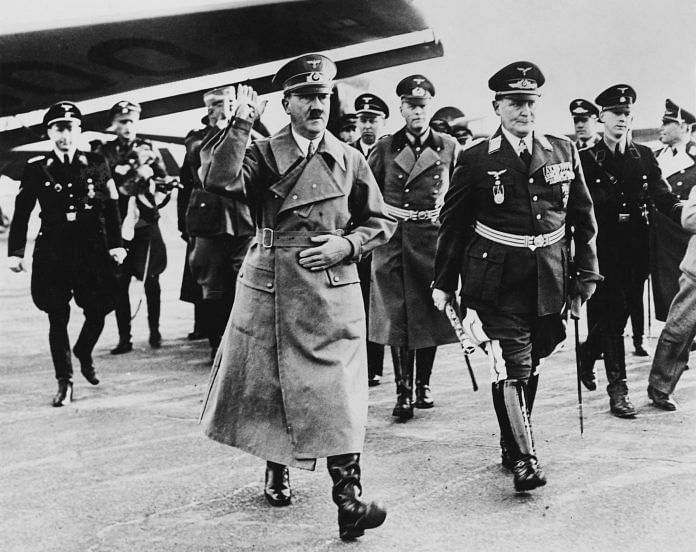A parallel between the genocide under Hitler and the Emergency diminishes the suffering experienced by victims of World War II.
New Delhi: Using the Emergency anniversary Monday as fresh fodder to attack the Congress, union minister Arun Jaitley compared Indira Gandhi to German dictator Adolf Hitler, who oversaw millions of executions during World War II.
“There were striking parallels between the way Indira suspended fundamental rights and persecuted political opponents and the manner in which Hitler installed himself as the sole ruler in Germany,” Jaitley wrote in a post on Facebook.
PM Narendra Modi backed Jaitley’s comments, made in a three-part series titled ‘The Emergency Revisited’, by tweeting the links to the posts to his 43 million followers.
Shri @arunjaitley writes about the dark days of the Emergency, the trampling of personal liberties, excesses committed and how the Emergency was a direct attack on our Constitutional ideals. Do read his blogs.
Part 1-https://t.co/0PPmNlLbc5
Part 2-https://t.co/50clvN4WxJ
— Narendra Modi (@narendramodi) June 25, 2018
Just before the clock struck midnight on 25 June 1975, the then Indira Gandhi-led Congress government declared a state of Emergency, which lasted for 21 months.
With widespread press censorship, the arrest of dissenters and opposition party members, suppression of civil liberties, and forced sterilisation, the Emergency is regarded as one of the darkest periods of modern Indian history.
However, despite the trauma that still haunts those who lived through the Emergency, Jaitley’s comparison between Indira and Hitler is far from accurate. On the contrary, a parallel between the genocide and human rights abuse under Hitler and the 21 months of the Emergency diminishes the suffering of World War II victims.
For a quick lesson in history, here are some facts about Hitler’s regime:
64 million – The estimated number of people who died during World War II around the world. For context, the current population of the UK is 66.5 million.
6 million – Number of Jews murdered by the Nazi regime’s ‘elite’ political soldiers, the SS, on the direct command of the führer during the Holocaust.
1.5 million – Number of children murdered.
7 million – Civilians of the erstwhile Soviet Union killed, including 1.3 million Jews (figure included in the overall Jewish toll of six million).
5 million – Number of non-Jewish people murdered during the Holocaust.
These include Soviet prisoners of war, Jehovah’s Witnesses, homosexuals, dissenting clergy, communists, socialists, ‘asocials’, nomads, Slavs, Poles, Roma (gypsies), African-Germans, and the physically and mentally disabled.
100,000 – Number of men arrested for being homosexuals. Homosexuals were beaten, their testicles boiled in water, and sodomised by broken broomsticks. They were often used by the SS as target practice for firearms training.
300,000 – 400,000 – Number of forced sterilisations undertaken. The general method of sterilisation was vasectomy and ligation of the fallopian tubes.
4.30am – When work began for prisoners in concentration camps.
22 – Number of countries invaded by Hitler after the start of World War II in 1939.
200 billion reichsmark – The officially admitted debt of the Reich, which would roughly translate to more than $80 billion, in 1938, before the war began.
25,000 – Number of books burned by Nazi student organisations, professors, and librarians on the night of 10 May 1933. Some were works of Jewish writers, including Albert Einstein and Sigmund Freud. These were books the Nazis viewed as espousing ideas different from their own and therefore “not to be read.”
3,600 – Number of newspapers and magazines supervised by Joseph Goebbels, the head of the ‘ministry of popular enlightenment and propaganda’. The Reich Press Law, on 4 October 1933, stated that all journalism had to be “racially clean”.
400 – Separate regulations issued during the twelve years of Hitler’s Reich targeting Jews. These regulations placed wide-ranging restrictions on members of the community, from the kind of pets they could have to whether they could take part in a symphony orchestra.
During his regime, Hitler changed laws regarding press regulation, freedom of speech, what constituted ‘illness’, and introduced the Nuremberg (racial) laws of 1935, which prohibited Jews from German citizenship as well as marriage and sexual relations with Germans.



